Be careful with conventional “wisdom”—especially when it comes to dividend investing. Some investors are so scared of a payout cut that they chase too-popular yields and watch their money grind sideways for years on end.
This safety trap is especially tempting in 2020, with dividend cuts happening left and right. We’ve had 639 publicly traded US companies reduce or eliminate their payouts in the second quarter alone, according to S&P Dow Jones Indices.
If you’ve been burned by a payout cut this year, the small consolation is you’re far from alone. Many folks were caught off guard when big names like Ford (F), Wells Fargo (WFC) and senior-care REIT Welltower (WELL) slashed or ceased their dividends.
Dividend Aristocrats Offer Protection—but at a Cost
This is where the trap I mentioned earlier comes in. It involves the Dividend Aristocrats, the 66 stocks that have raised their payouts for 25 straight years or more. These companies might also tempt you because many are household names, with 3M (MMM), Johnson & Johnson (JNJ) and Coca-Cola (KO) all making the list.
Moreover, the Aristocrats have been an oasis of dividend calm in this crisis: according to ProShares (whose Aristocrat-focused ETF we’ll discuss in a second), just one Aristocrat cut its dividend in the second quarter.
Unfortunately that’s where the good news ends.
Case in point: despite the “dividend” in their name, these stocks only pay a shade more than the typical S&P 500 stock.
Right now, for example, your average S&P 500 firm yields 1.7%. So if you were to invest, say, $500K, you’d get $8,500 in dividend income. The Aristocrats? With a 2.1% payout, you’d get $10,500 on your $500K. You’re not retiring on that, either!
And while some individual Dividend Aristocrats perform well (more on one of those below), simply buying a stock because it belongs to this club, or investing in the Aristocrats through an ETF like the ProShares S&P Dividend Aristocrats ETF (NOBL), virtually guarantees underperformance.
That’s because NOBL trails the S&P 500 over just about every timeline you can think of, even with dividends included! Let’s start with year to date (with NOBL in orange):
Aristocrats Whiff Once …

That’s a wide gap. And it gets wider as we lengthen our timespan. Look at the last full year.
… Twice …
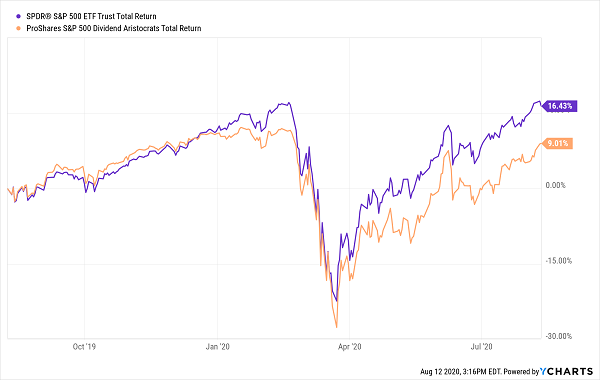
Now the last five years.
… Three Times …
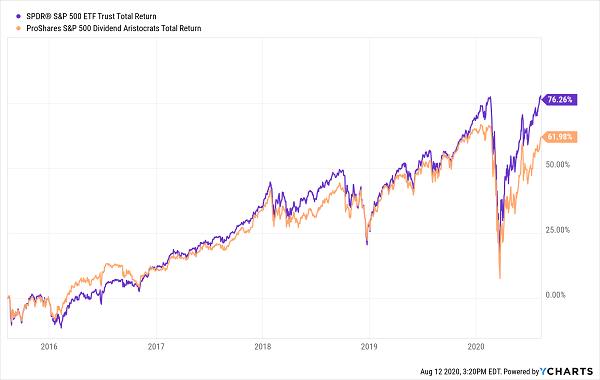
And finally, the last decade.
… and Four
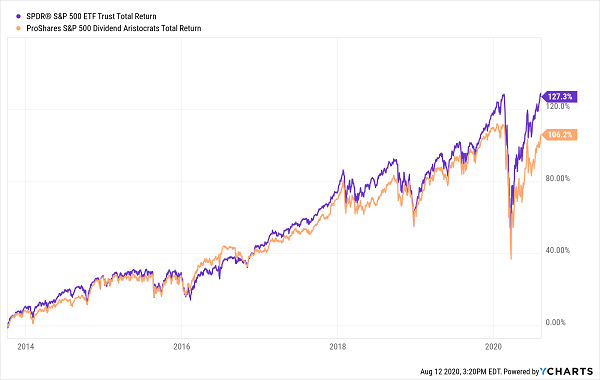
This is disappointing when you consider that these stocks should have a built-in edge due to their continuous payout growth. That’s because a rising dividend is a key catalyst for share prices, as news of a payout hike is almost certain to draw income-hungry investors in.
Few people pay attention to the connection between share-price appreciation and dividend growth, but it’s a pattern I’ve seen time and time again. That’s why it’s a key part of the strategy I use in my Hidden Yields dividend-growth service.
To see what I mean, take a look at Texas Instruments (TXN), which has soared 74% since I recommended it in June 2017, nearly double the S&P 500’s 39% gain. And look at how the share price has followed the dividend higher—point for point! The pattern is unmistakable.
TXN’s Dividend Ignites Its Share Price
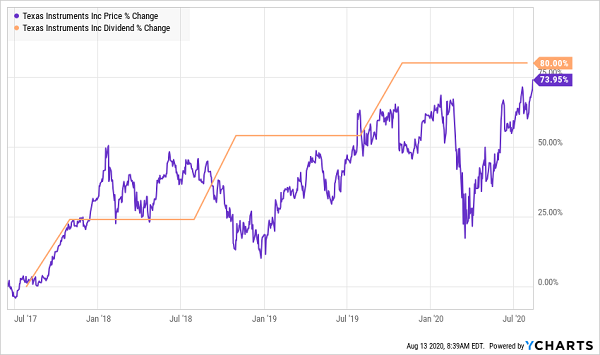
So where does this leave the Aristocrats?
The trouble with these stocks as a group is that they’re weighed down by companies that raise their dividends a tiny amount every year, just to stay in the club! That does little for their share prices. And just as a rising dividend pulls share prices up, a stagnant payout can weigh a stock down, too.
AT&T: An Overhyped Aristocrat
Consider AT&T (T), which gets a lot of attention due to its high current yield, which is 6.9% today. That sounds great until you see this chart:
Lame Payout Growth Drags Down AT&T …
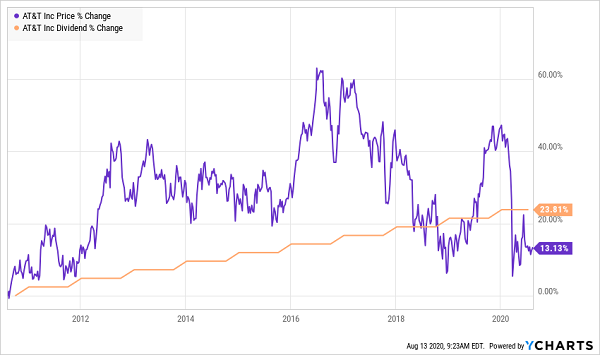
That 23.8% dividend growth is pathetic over a 10-year timespan (it’s literally a penny a year). Compare that with Texas Instruments, which inflated its payout 80% in just over three years!
It’s only a matter of time until weak payout growth like that shows up in the share price. We can see that in the chart above: when the coronavirus put AT&T’s stock to the test, it failed miserably, falling much further than the market.
And while the S&P 500 is now positive on the year, AT&T is still on the mat, even though it’s well-suited to this crisis, as we all sit at home and burn through mobile data, desperate for something to entertain us:
… and Dividend Investors Hang Up
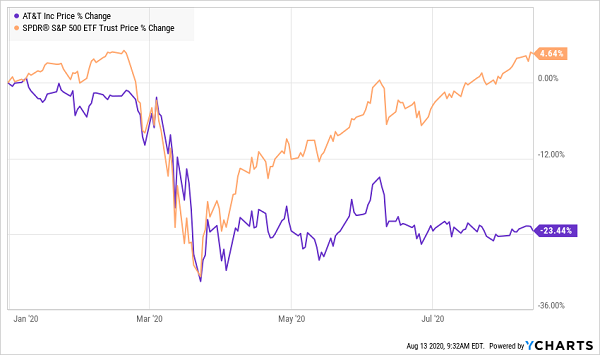
Some Aristocrats Are Strong Performers—but Everyone Knows It
One thing we shouldn’t do is take AT&T’s example to mean all Aristocrats are poor investments. Some do grow their payouts faster than average, driving strong share-price growth as they do. Trouble is, you’ll rarely get a deal on these investor darlings—and certainly not these days.
Take McDonald’s (MCD), which has boosted its payout 127% in the last decade. Its stock followed suit—a bit too much. It’s up 187%, well ahead of the company’s dividend growth.
McDonald’s Share Price: Overcooked

That’s a clear sign a dividend grower is overvalued. And a quick check of the company’s trailing-12-month P/E ratio confirms it: the burger flipper now trades at 33-times earnings, the highest since 2007!
2 Overvaluation Signals Align
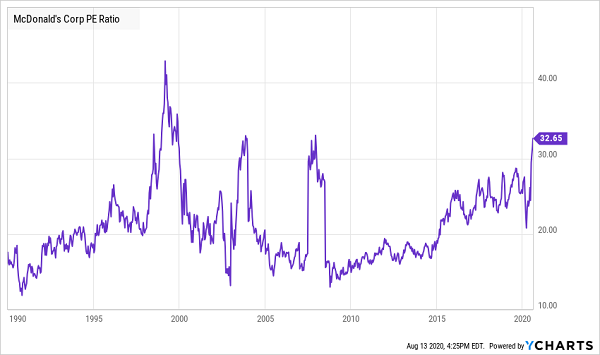
That’s as clear an indication as any that we need to look beyond the Dividend Aristocrats if we want to grow our nest egg and income stream.
And the best way to do that is with …
7 Accelerating Dividends That Crush This Crisis, Double Your Nest Egg
As I’ve just shown you, the Dividend Aristocrats mostly break out into two groups:
- Lazy dividend raisers that hike their payouts just enough to keep their streaks going, and …
- Strong performers that are just too pricey now that the market has rebounded.
There are exceptions, of course, but here’s the upshot: if we want to double our nest egg—and our income stream—we need dividends that are accelerating, not merely bumping along, like AT&T’s tired payout.
That’s why I just released 7 underappreciated stocks whose payouts are set to surge for years to come, pandemic or no.
If you add them to your portfolio right now, you can look forward to double-digit gains—while enjoying steady, growing dividends—no matter how long this crisis drags on, and no matter how low the markets crash.
That’s right, even if the Dow collapses another 1,000, 2,000, even 5,000 points, I’d still be buying these 7 ironclad stocks … and I suggest you do the same.
Normally I reserve the details on investments like these for members of my Hidden Yields service, but given the unprecedented situation we’re facing today, I’m going to share them with you now.
